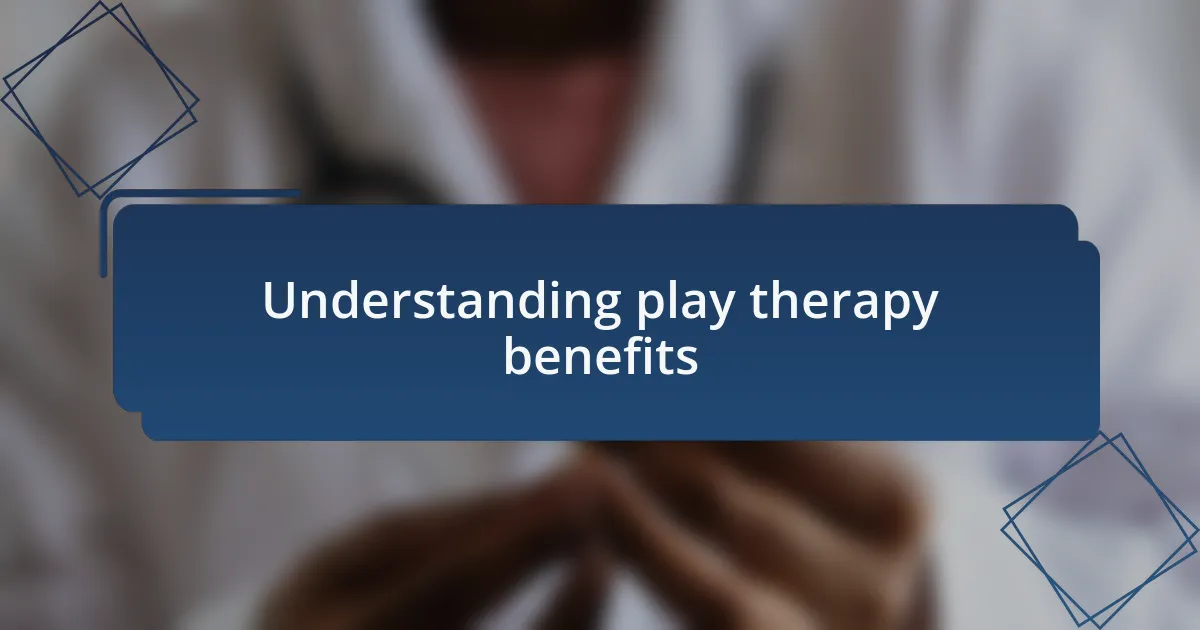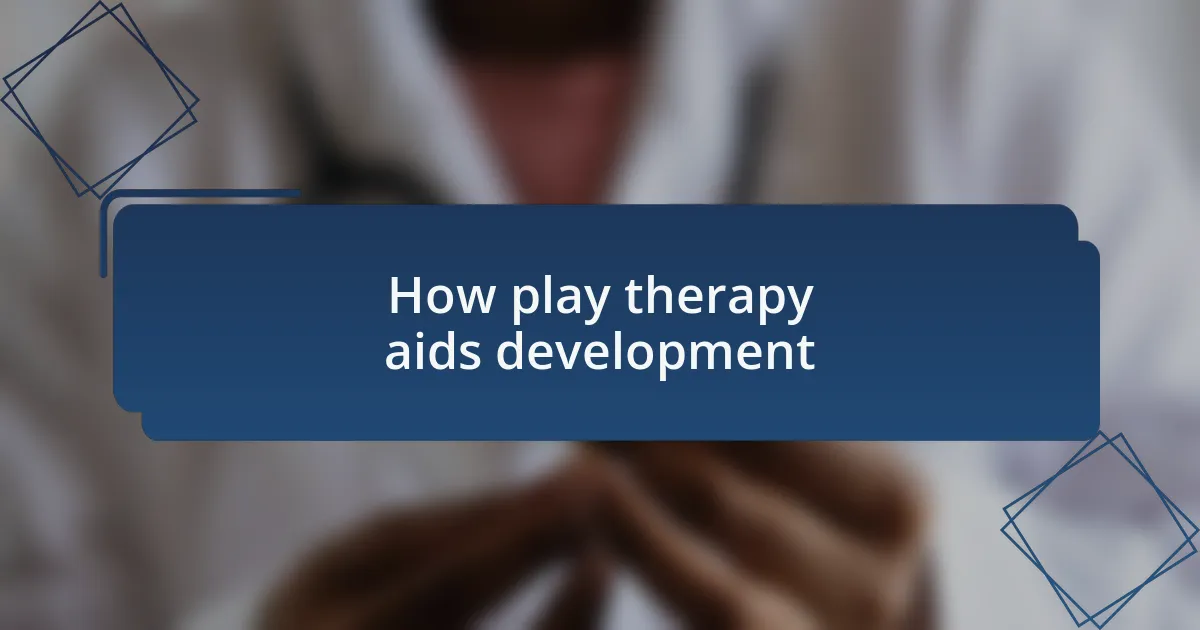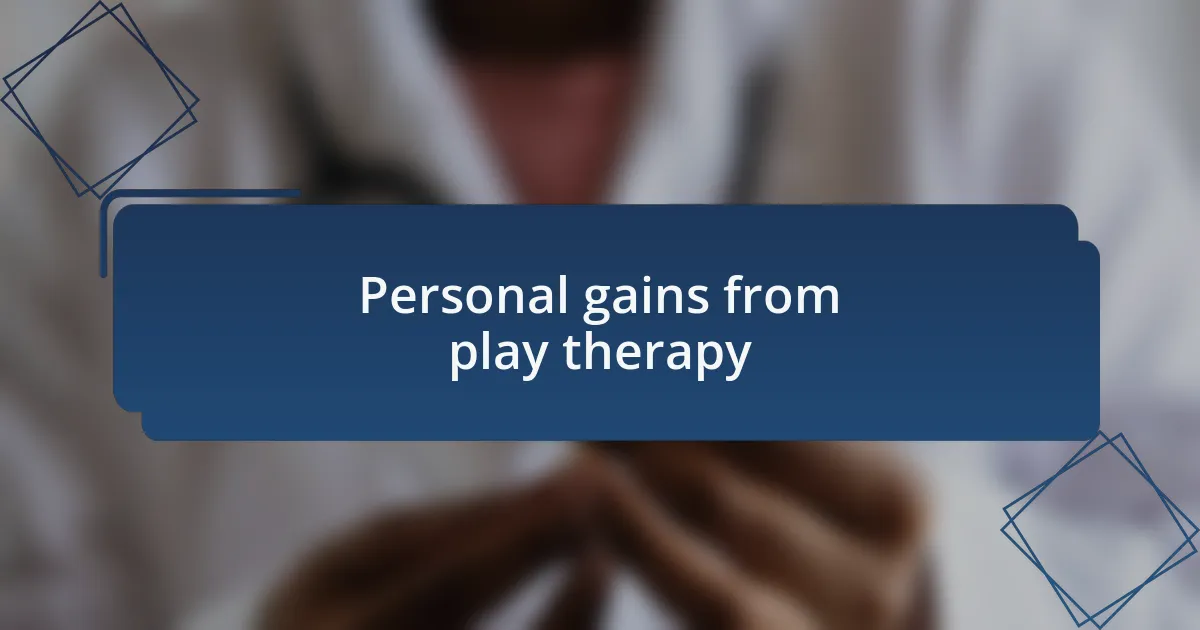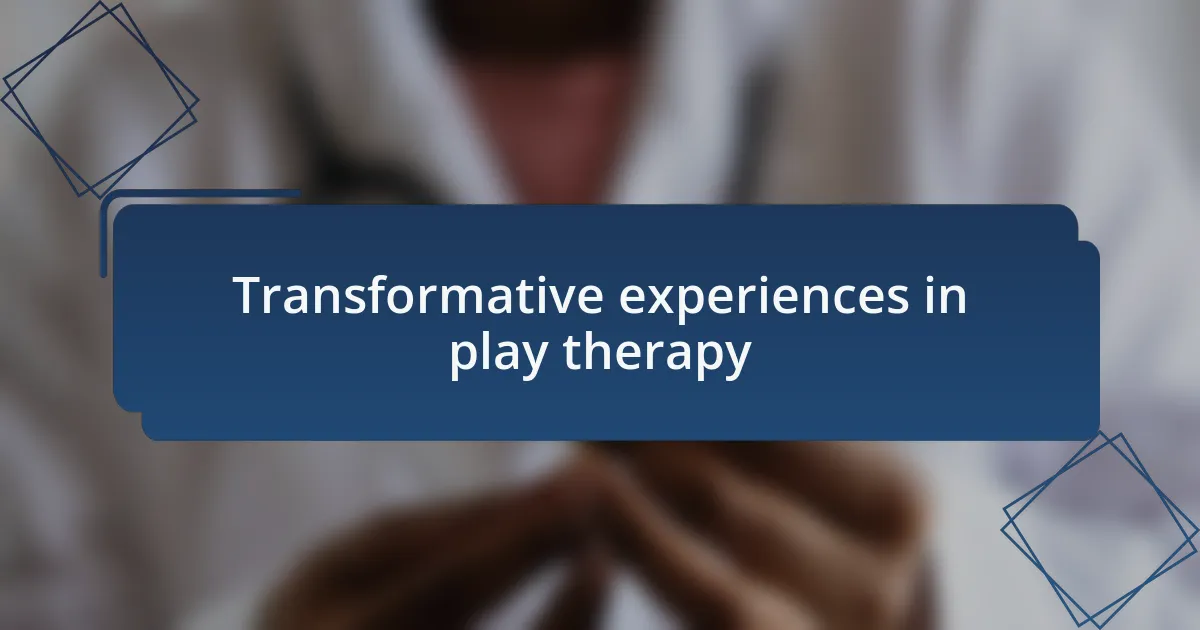Key takeaways:
- Play therapy offers a powerful way for children to express emotions and develop social skills through imaginative play.
- Support for children with cerebral palsy involves a range of services, including physical therapy, which enhances independence and emotional resilience.
- Creative activities in play therapy stimulate cognitive development and allow children to process feelings in a safe environment.
- Creating a welcoming therapy space and incorporating various play modalities can significantly enhance a child’s engagement and therapeutic outcomes.

Understanding play therapy benefits
Play therapy offers a unique avenue for emotional expression, especially for children who might struggle to articulate their feelings verbally. I remember the first time I saw a child with cerebral palsy unlock their emotions through play—using dolls to act out a situation they couldn’t quite explain. It was a profound moment that highlighted how play can serve as a powerful communicator.
One of the most remarkable benefits of play therapy is its ability to foster social skills. I’ve witnessed a child gradually build friendships through shared imaginative games, which allowed them to practice important social cues in a safe environment. Have you ever thought about how a simple game can turn an awkward moment into a foundation for lasting relationships?
Additionally, play therapy can significantly reduce anxiety by creating a comfortable space for exploration. I’ve seen children let go of their worries, engaging fully in activities that brought joy and distraction. This transformative aspect of play therapy leaves me wondering—what could be accomplished if we all embraced the healing power of play in our lives?

Overview of cerebral palsy support
Cerebral palsy support encompasses a variety of services aimed at enhancing the lives of those affected by this condition. I’ve often seen families navigate a complex world of therapies, educational plans, and community resources, all tailored to help their loved ones thrive. It reminds me of a time when a mother shared how overwhelming it was to piece together the right support for her child’s unique needs.
One key element of support is physical therapy, which not only improves mobility but also boosts independence. I once worked with a young boy who struggled with everyday tasks. Celebrating his small victories, like tying his shoes for the first time, was a reminder that each step forward, no matter how small, can significantly impact a child’s confidence and overall development.
Additionally, emotional and social support plays a vital role in the journey of those with cerebral palsy. I recall a community event where children and their families connected, sharing laughter and experiences. Isn’t it powerful how a supportive network can transform feelings of isolation into a sense of belonging? These connections can be life-changing, fostering resilience and hope in the face of challenges.

How play therapy aids development
Play therapy can truly be a game changer in the developmental journey for children with cerebral palsy. I remember observing a therapy session where a child seamlessly transitioned from frustration to joy while building with blocks. This kind of engagement not only enhances motor skills but also fosters problem-solving abilities, allowing the child to experience achievement in a supportive environment.
Through play therapy, I’ve noticed that children often open up emotionally in ways that traditional therapies might not allow. In one instance, a little girl expressed her fears about not fitting in during playtime. Watching her use dolls to act out scenarios helped her process those feelings and develop social skills in a comfortable and relatable context. Isn’t it fascinating how play can bridge the gap between emotional expression and developmental growth?
Moreover, the creativity involved in play therapy stimulates cognitive development in delightful ways. I recall a session where children were encouraged to invent their own games. The laughter and excitement that erupted not only fostered collaboration but also ignited their imaginations. Who knew that such playful moments could lead to enhanced critical thinking skills? It’s clear to me that play therapy not only nurtures a child’s immediate developmental needs but also lays a lasting foundation for future learning and social interactions.

Personal gains from play therapy
Reflecting on my experiences with play therapy, it’s evident that the personal gains go beyond skill acquisition. I witnessed a young boy, initially reluctant to engage, gradually shed his reservations as he interacted with building toys. His face transformed with each successful tower he created, revealing not just newfound confidence but a genuine sense of joy. It made me wonder, how much does self-esteem flourish when children are met with encouragement through play?
Emotionally, the benefits are profound. I remember a session where a child shared her anxiety about her physical challenges using art supplies. As she painted her feelings, it was as if she found a voice for emotions she didn’t know how to articulate before. This breakthrough was a testament to the therapeutic potential of play, leading me to ask, how often do we underestimate the power of creative outlets to heal?
The social gains from play therapy are equally remarkable. Observing a small group of children collaborate on a pretend play scenario was enlightening; their laughter echoed, reflecting a blossoming sense of camaraderie. In that moment, it struck me how play nurtures friendships and teaches invaluable lessons about teamwork, often more effectively than structured activities ever could. Isn’t it amazing how these simple interactions boost not only communication skills but also empathy?

Transformative experiences in play therapy
Transformative experiences in play therapy can unfold in unexpected ways. I recall a session where a child faced immense frustration when attempting a new puzzle. Instead of giving up, I watched as he took a deep breath and revisited the pieces with determination. It made me reflect on resilience; how often do we surprise ourselves with our ability to overcome obstacles when given the right environment?
Another poignant moment occurred when a child used a puppet to express feelings towards a family situation he found challenging. The puppet became his voice, and suddenly, barriers melted away, leading to discussions I never thought possible. This connection through play emphasized how exploring emotions in a safe space can unlock truths that feel too heavy to share directly. Isn’t it fascinating how role play can facilitate healing in ways that direct conversation sometimes can’t?
The cooperative play scenarios I’ve observed highlight the essence of empathy among children. In one memorable instance, two kids built an elaborate fort together, seamlessly sharing ideas and materials. Their collaborative spirit not only resulted in a tangible creation but also fostered a bond based on trust and understanding. I often wonder, how does such shared creativity reshape their perspectives on relationships beyond the therapy room?

Recommendations for effective play therapy
When considering play therapy, one key recommendation is to create a space that feels welcoming and safe. I remember a particular session where I chose to decorate the therapy room with bright colors and engaging materials. The instant shift in the child’s demeanor was striking; they immediately felt more at ease, ready to explore their feelings through play. Don’t underestimate how the physical environment can influence a child’s willingness to engage.
Another vital aspect is to allow for spontaneity in sessions. I found that when I followed a child’s lead—whether they wanted to build, create, or even knock things down—the session transformed into a shared journey of discovery rather than a rigid structure. This flexible approach often leads to unexpected breakthroughs. Have you ever noticed how children can create magic simply by being given a chance to express themselves freely?
Lastly, it’s important to incorporate a variety of play modalities to meet each child’s unique needs. In one instance, I introduced art supplies alongside traditional toys, and it opened new avenues for a child who was initially reluctant to verbalize their feelings. They poured their emotions into painting, revealing insights that words couldn’t capture. Isn’t it incredible how different forms of expression can enrich a child’s therapeutic journey?